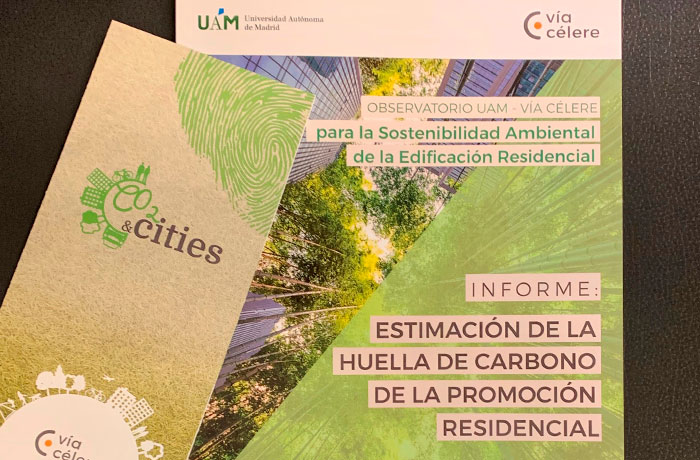Every square metre built in residential construction accounts for 441 Kg of CO2
- A study by the UAM-Vía Célere Observatory study on environmental sustainability has calculated the carbon footprint of a residential development containing 98 homes, giving a carbon footprint of 6,809 tonnes of CO2 eq. similar to the emissions from a motor vehicle travelling 4,400 times around the earth’s diameter.
Every square metre built in residential construction accounts for 441 Kg of CO2 eq. This is the main finding of the second study conducted by the Observatory for the Environmental Sustainability in Residential Building promoted by Vía Célere, the Autonomous University of Madrid and the UAM Foundation, which was presented today at a public event held at the Cotec Foundation, in the context of a wider dialogue on Sustainable Cities that has also involved the participation of Forética and the Spanish Office on Climate Change and the collaboration of Greemko.
This study, which took Vía Célere developments as an example, estimated how many greenhouse gases, such as CO2, are generated by the construction of a residential complex, including from the extraction of the materials to the completion of the building. In total, the development studied containing 98 homes and almost 15,500 square metres would involve the emission of 6,809 tonnes of carbon dioxide to the atmosphere, equivalent to the emissions generated by an average motor vehicle travelling 4,400 times around the earth’s diameter.
Furthermore, the investigation also pointed out that 70% of the greenhouse gas emissions were the result of the processes of extraction and manufacture of steel and cement, two basic materials in the construction of buildings. Meanwhile, the construction process itself generates 4.4% of the total.
Célere Cities, sustainable cities, and urban environments
The activity of the Observatory for the Environmental Sustainability in Residential Building, and this new study, is encompassed within Vía Célere’s commitment to creating more sustainable cities and urban environments. In this way, Célere Cities forms part of the company’s strategy, through which it reaches out to its stakeholders to continue to move forward in the construction of cities that are more respectful of the social surroundings and the environment, in line with the New Urban Agenda and the Sustainable Development Goals.
In this second year, Célere Cities has chosen to focus its attention on CO2 emissions, after concentrating in 2019 on the water footprint in residential construction. This area of study is especially relevant since the world’s cities occupy only 3% of its land but represent between 60% and 80% of energy consumption and 75% of carbon emissions.
Within the EU, buildings are responsible for approximately 40% of energy consumption and 36% of CO2 emissions. Approximately 35% of the buildings are over 50 years old and almost 75% of the real estate stock lacks energy efficiency.
“At the Observatory for the Environmental Sustainability in Residential Building we study the aspects of the construction process that require more attention to ensure that our activity is more respectful to the environment and contributes to creating a better urban environment” said José Ignacio Morales Plaza, CEO of Vía Célere. In this respect, the study carried out by Vía Célere and the UAM, in addition to obtaining information about the CO2 generated throughout the construction process and the materials involved, also identifies lines of action with which to increase sustainability in residential construction regarding the emission of CO2. “Through Célere Cities, we aim to work with our collaborators to reduce our carbon footprint as much as possible, contributing to moving towards more sustainable construction in line with the global commitments of the fight against climate change” added Morales Plaza.
The study is available for download from www.viacelere.com/celere-cities


